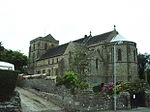RAF Cark
Military units and formations disestablished in 1947Military units and formations established in 1941Royal Air Force stations in CumbriaRoyal Air Force stations in LancashireRoyal Air Force stations of World War II in the United Kingdom ... and 2 more
South Lakeland DistrictUse British English from March 2018
Royal Air Force Cark or more simply RAF Cark is a former Royal Air Force station in the county of Cumbria (formerly Lancashire) which was operational between 1941 and 1945. It was built near the villages of Cark and Flookburgh on the Cartmel Peninsula which today forms part of Cumbria.
Excerpt from the Wikipedia article RAF Cark (License: CC BY-SA 3.0, Authors).RAF Cark
Willow Lane,
Geographical coordinates (GPS) Address Nearby Places Show on map
Geographical coordinates (GPS)
| Latitude | Longitude |
|---|---|
| N 54.1625 ° | E -2.9583333333333 ° |
Address
Cark
Willow Lane
LA11 7LU , Lower Holker
England, United Kingdom
Open on Google Maps









